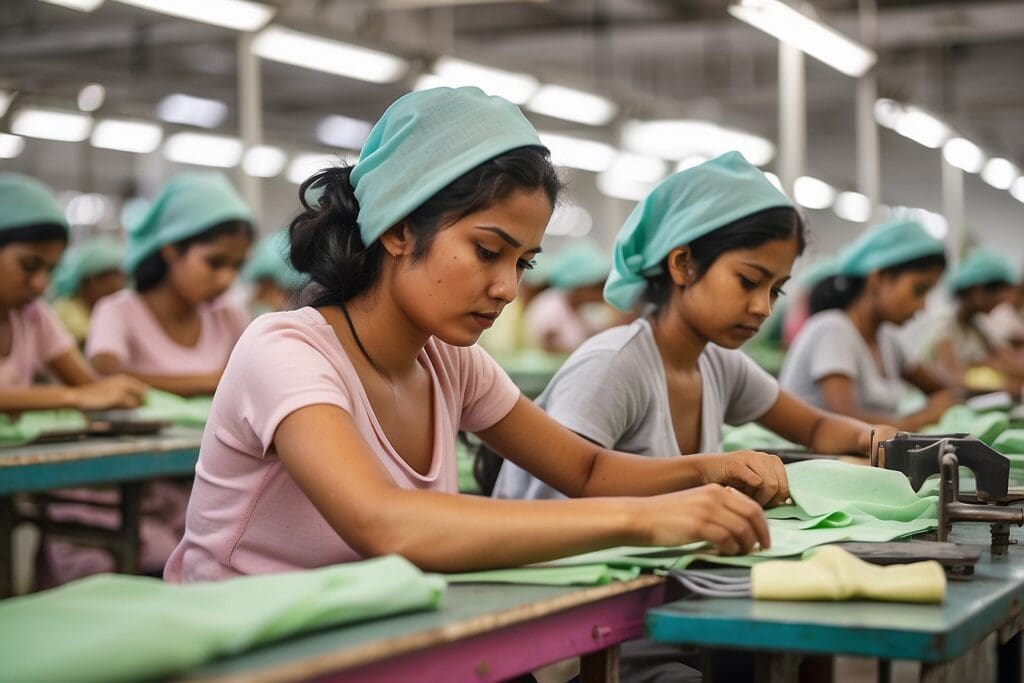Sweatshops are working environments that are unacceptably dangerous or difficult. Sweatshop workers—which may include young children, slaves, and illegal immigrants—work long hours in unsanitary conditions for very low wages. The United States General Accounting Office defines a sweatshop as a workplace “that violates more than one federal or state labor law governing minimum wage and overtime, child labor, industrial homework, occupational safety and health, workers compensation, or industry regulation.”1 The term “sweatshop” was coined in the late 19th century, and sweatshops still exist today in both developed and developing nations. According to U.S. Department of Labor estimations, in 1996 they believed there were at least 11,000 garment shops that qualified as sweatshops operating in the United States.2
Obviously, sweatshops are a human rights issue. Sweatshops are also an environmental issue.
Countries that allow sweatshops to proliferate also tend to have lax environmental laws. For example, the Hazaribagh district of Dhaka, which is the capital of Bangladesh, has about 200 leather tanneries that discharge 22,000 cubic meters of untreated liquid waste daily into rivers and groundwater. As a result, the Buriganga River—which thousands of people still depend on for bathing, irrigation, and transportation—is now black and biologically dead.4 Workers at the tanneries suffer the greatest injustices, being forced to process rawhides soaked in toxic chemicals, oftentimes in highly polluted air due to lack of ventilation.5 Sweatshops penalize workers for attempting to form labor unions, which are organizations of workers that band together to achieve common goals such as better working conditions. If the leather workers in Bangladesh had the opportunity to rally for their best interests, they would undoubtedly minimize their exposure to toxic chemicals and consequently reduce pollution levels in nearby rivers.
Because sweatshop workers work long hours for low pay, they have little opportunity to fight for the conservation of their environment. Over three billion people in the world live on less than $2.50 day, and about half of all children live in poverty.6 When children work in sweatshops instead of classrooms, they miss out on the opportunity to ever read a book or to even sign their names. In this age of communication, how will these children ever be able to make their voices heard? Even if by some remarkable feat they find the time and energy to fight for their health and their environment, will anyone listen?

How you can help
What we buy matters, because many of the companies we invest our money in support sweatshops. The clothing industry is notorious for its unfair working conditions. Here’s an example: you know those jeans with that fashionable faded look? To achieve that appearance, many garment companies sandblast the fabric. Workers in and around the factories inhale the dust, which in some cases leads to silicosis and even death. Yikes! Some companies (such as Levi-Strauss) have pledged to ban sandblasted jeans from their products but others refuse to.8
Unfortunately, it’s hard to pin down exactly who made our shirts and how they made them, especially when the shirts come from halfway around the world and are sewed in factories that are neither owned nor operated by the fancy brand emblazoned across the shirt’s breast pocket. Lots of big brands are suspected of following unethical labor practices, including: H&M, Abercrombie and Fitch, The Gap (which includes Old Navy and Banana Republic), Nike, Calvin Klein, Wal-Mart, Limited Brands (which includes Victoria’s Secret, Bath and Body Works, Express, and The Limited).9 Yes, this does wipe out at least half of your local mall. But don’t worry, there are many ethical companies that sell fair trade clothing. To find them, browse Green America’s National Green Pages and learn more at Green America’s Responsible Shopper. Fair Trade USA launched the first sweat-free garment certification label, so make sure to look for “Fair Trade Certified” before making your next purchase!10
Of course, the simplest way to keep your dollars from enriching sweatshop companies is to buy less stuff in general. Reduce and reuse! Instead of visiting the mall, buy used at your local consignment stores, yard sales, and clothing swaps. If you’re interested in doing more, check out these organizations: Ella Baker Center, Good Jobs First, Green Worker Cooperatives, Miami Workers Center, SustainLabour, TransFair, and United for a Fair Economy. If you’re a student, get involved on campus with the group United Students Against Sweatshops (USAS), which is loud and active in over 250 colleges and universities. Join the fight for sweatshop-free labor conditions and workers’ rights!





